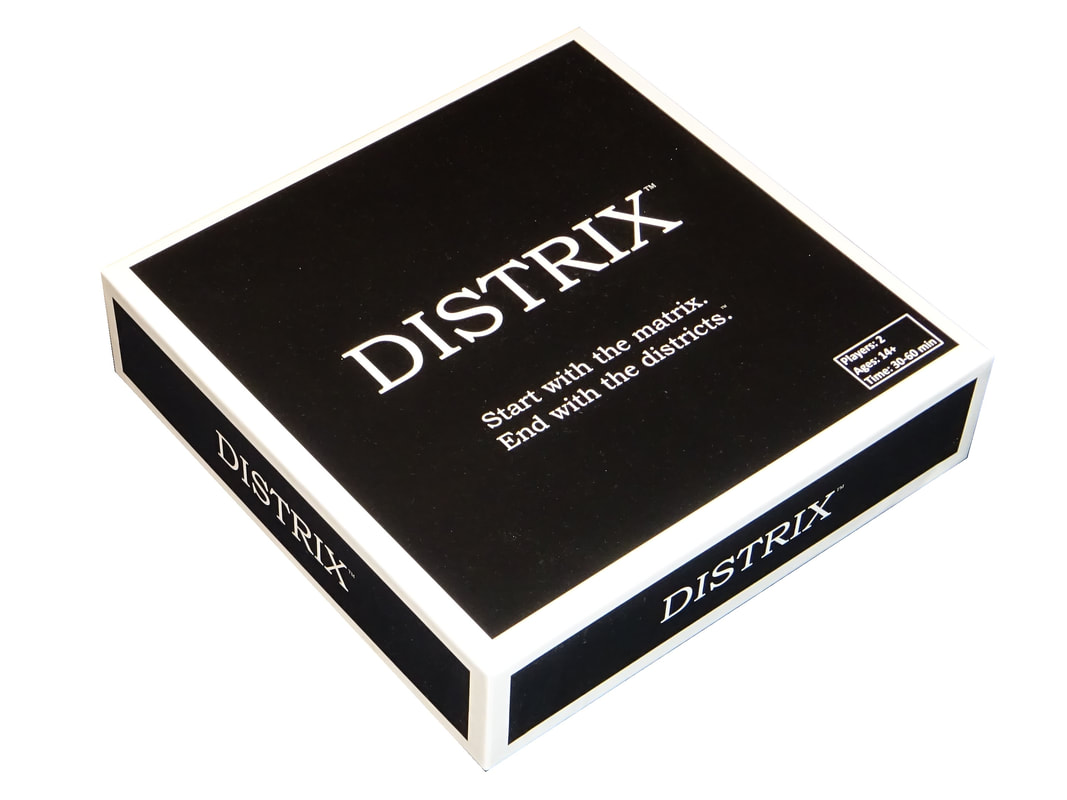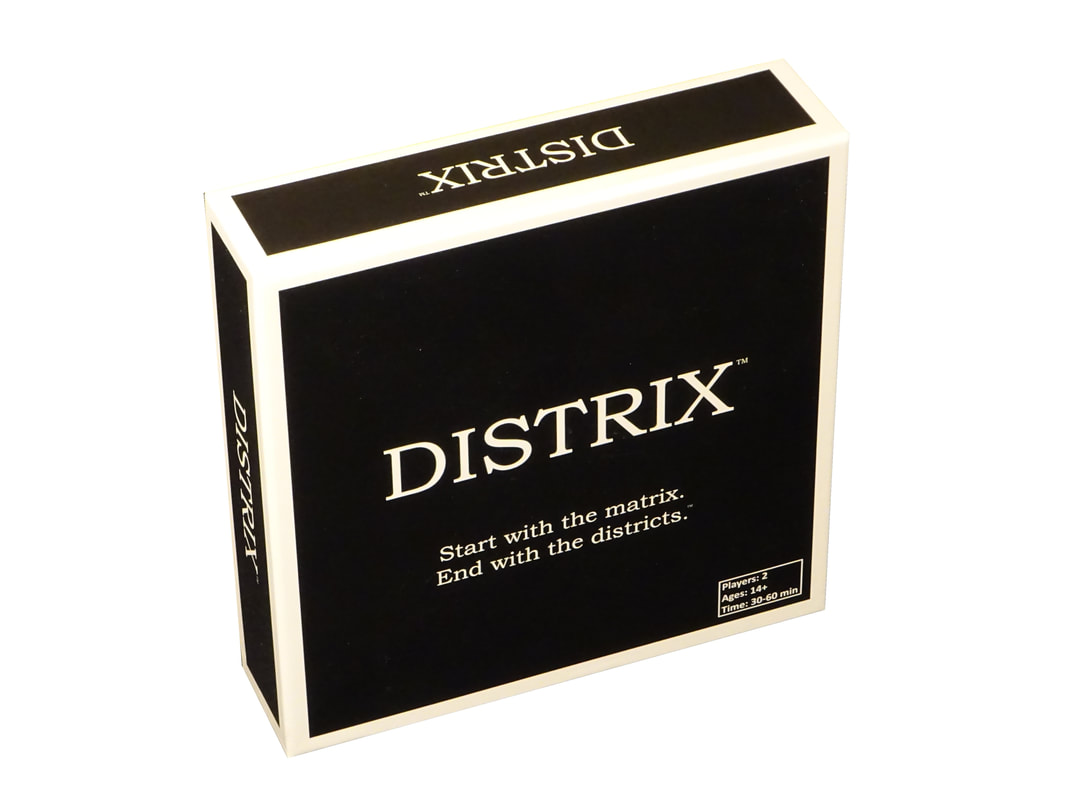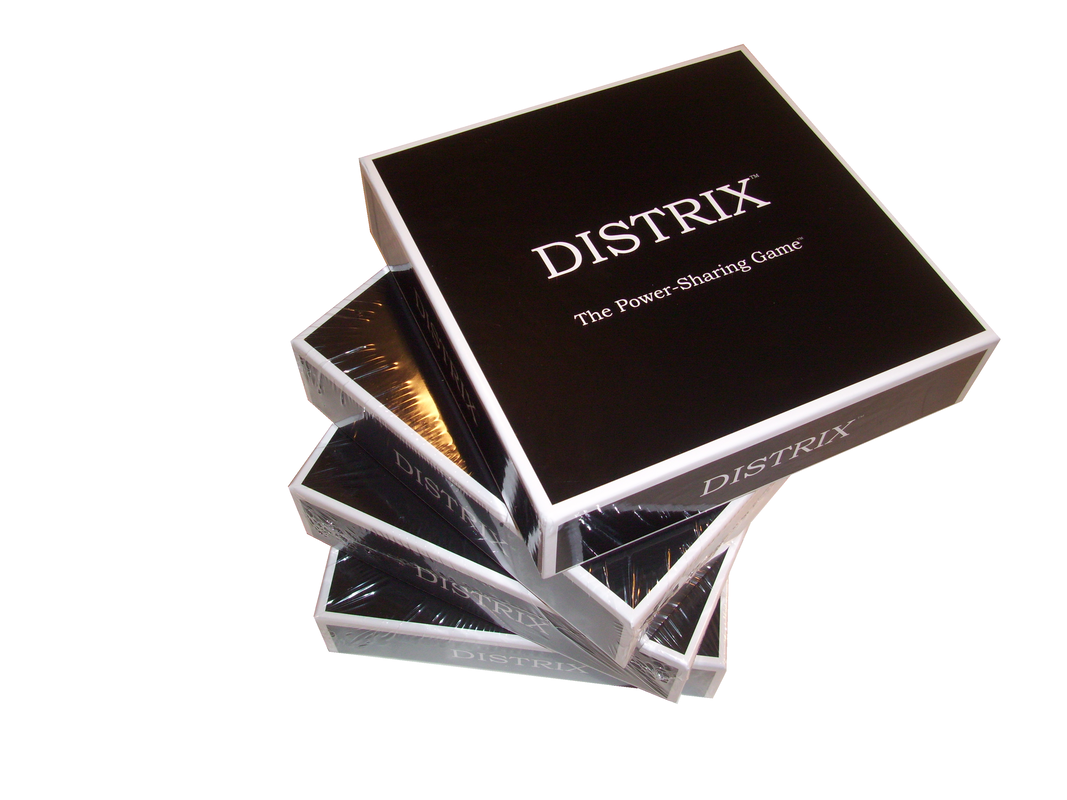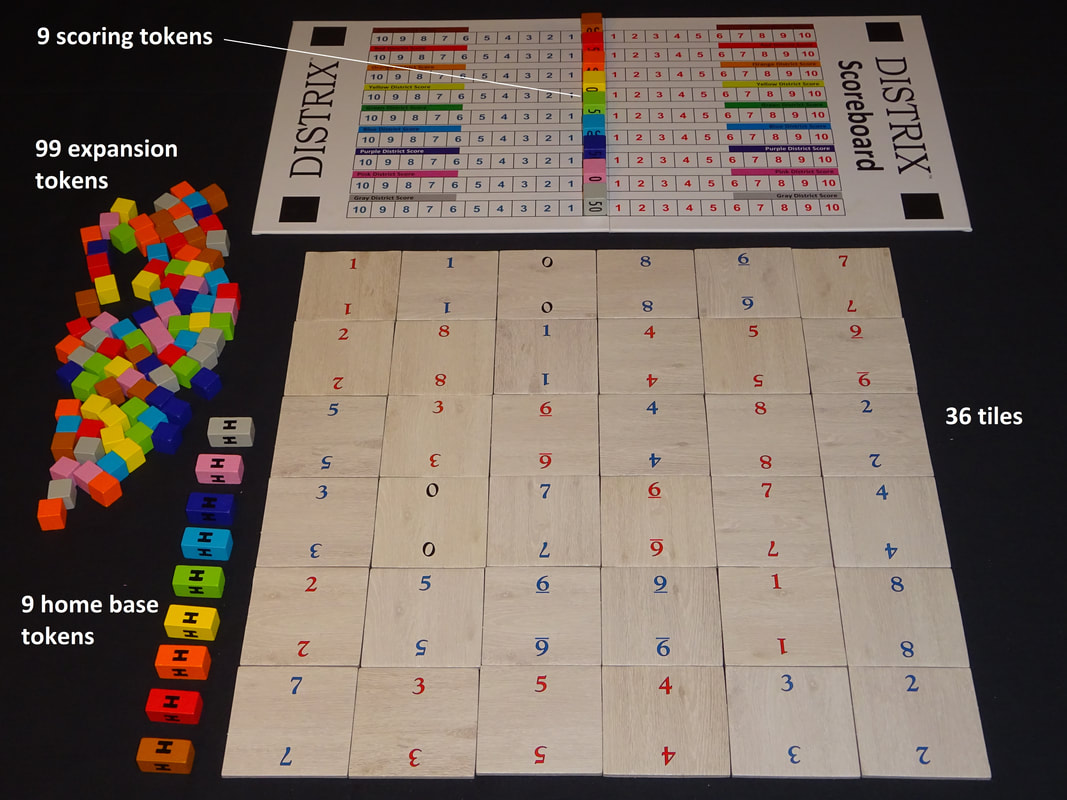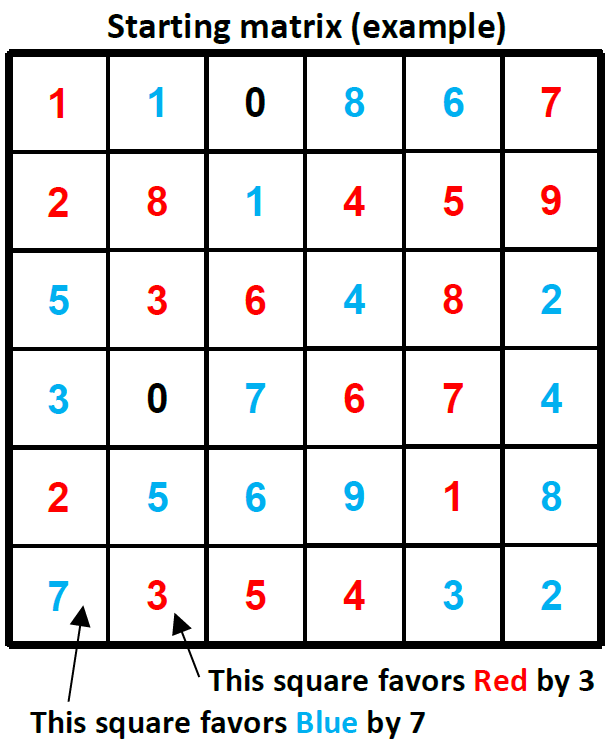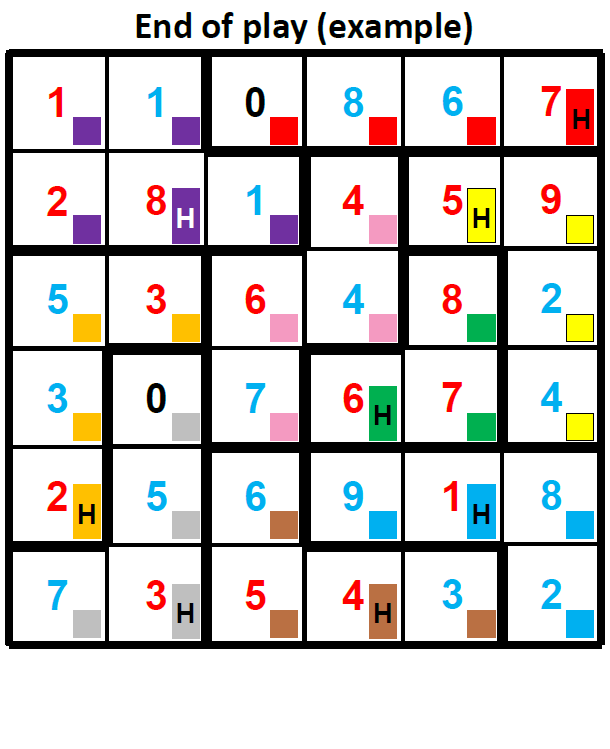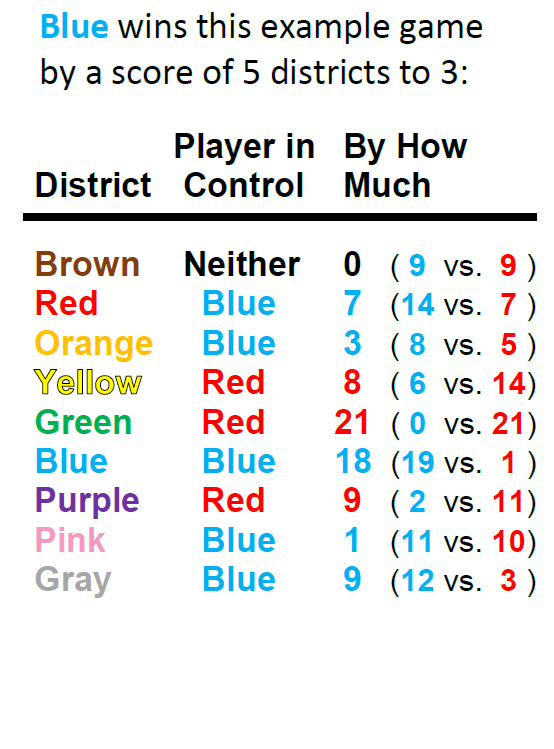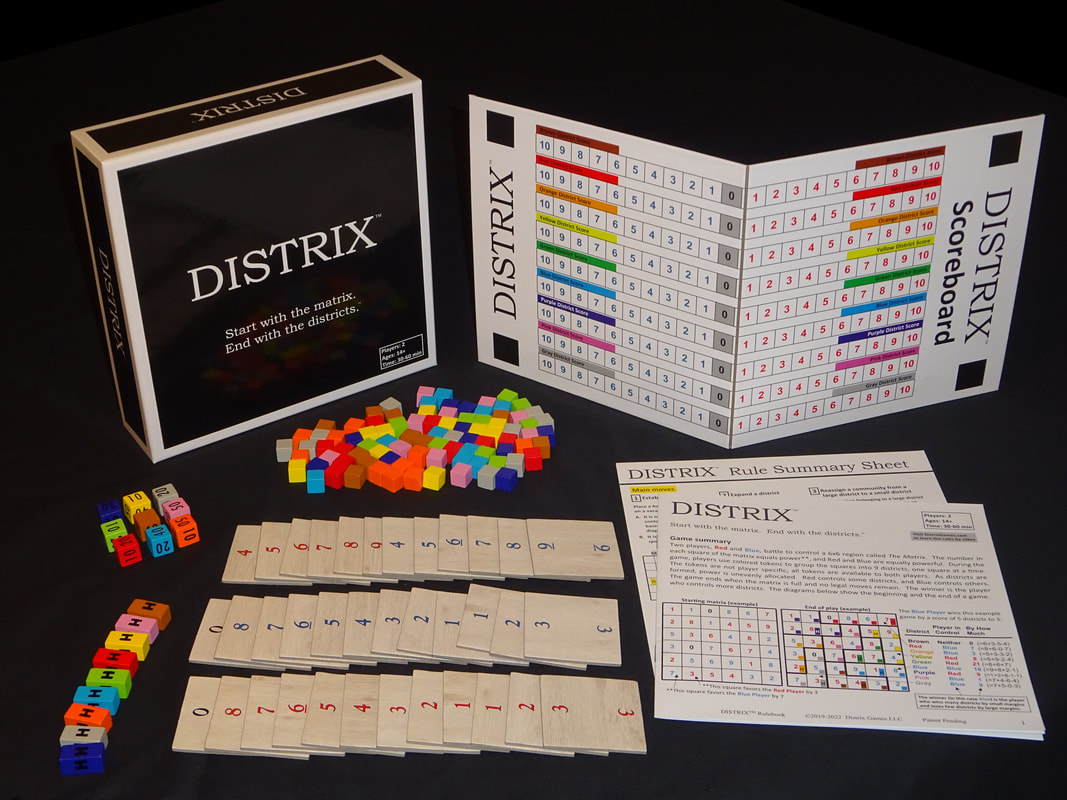Distrix: The Strategy Game
Players: 2
Ages: 14+
Time: 30-60 min
Box size: 8"x8"x2"
Ages: 14+
Time: 30-60 min
Box size: 8"x8"x2"
A Pure Battle for Power
Two players, Red and Blue, battle to control a 6x6 region called The Matrix. The number in each square of the matrix equals power, and Red and Blue are equally powerful. During the game, players assign squares to 9 districts, one square at a time. As squares are grouped into districts, power is unevenly allocated. Red controls some districts, Blue controls others. The game ends when all squares belong to districts and no legal moves remain. Whoever controls more districts is the winner.
The idea is simple, but game play is incredibly challenging. You and your opponent are always equally powerful, so there's one path to victory: you must cleverly spread your power to win many districts by narrow margins and lose few districts by large margins. This is how election districts are rigged, or gerrymandered, in the real world. But, in Distrix, an opponent responds to your every move. Each district is a tug-of-war that you want to win narrowly or lose by a lot. But be careful...you may accidentally win it by too much or barely lose it! Nine districts are in play, so there's a lot to keep your eye on. Spatial awareness is critical because the shape of one district affects another. And there's a special rule that's highly disruptive in the endgame: squares may be reassigned from large districts to adjacent smaller ones. Overall, it's a pure battle for power where basic arithmetic, spatial awareness, move timing, and move counting make all the difference. Play is intense from start to finish, and all games are closely contested.
A devilishly challenging affair, Distrix has the visual simplicity, aesthetic elegance, and sophistication of play typical of classic two-player games like chess and go. With razor-thin margins, endgame surprises, and a different matrix every time, Distrix is a game of skill like no other. Can you master the districts and win?
Two players, Red and Blue, battle to control a 6x6 region called The Matrix. The number in each square of the matrix equals power, and Red and Blue are equally powerful. During the game, players assign squares to 9 districts, one square at a time. As squares are grouped into districts, power is unevenly allocated. Red controls some districts, Blue controls others. The game ends when all squares belong to districts and no legal moves remain. Whoever controls more districts is the winner.
The idea is simple, but game play is incredibly challenging. You and your opponent are always equally powerful, so there's one path to victory: you must cleverly spread your power to win many districts by narrow margins and lose few districts by large margins. This is how election districts are rigged, or gerrymandered, in the real world. But, in Distrix, an opponent responds to your every move. Each district is a tug-of-war that you want to win narrowly or lose by a lot. But be careful...you may accidentally win it by too much or barely lose it! Nine districts are in play, so there's a lot to keep your eye on. Spatial awareness is critical because the shape of one district affects another. And there's a special rule that's highly disruptive in the endgame: squares may be reassigned from large districts to adjacent smaller ones. Overall, it's a pure battle for power where basic arithmetic, spatial awareness, move timing, and move counting make all the difference. Play is intense from start to finish, and all games are closely contested.
A devilishly challenging affair, Distrix has the visual simplicity, aesthetic elegance, and sophistication of play typical of classic two-player games like chess and go. With razor-thin margins, endgame surprises, and a different matrix every time, Distrix is a game of skill like no other. Can you master the districts and win?
Summary of play
- Decide who plays Red, who plays Blue, and who plays first
- Place 36 tiles in a random 6x6 matrix
- Players take turns. In each turn, a player uses one colored token to
- Establish a district,
- Expand a district, or
- Balance the sizes of 2 adjacent districts.
- Tokens are not player specific. As long as the rules are followed, any player may place any color token on any tile.
- The game ends when one token occupies each tile and there are no legal moves remaining
- Whoever controls more districts is the winner
Follow a Distrix game from start to finish
Reviews
Board's Eye View (Sept 15, 2021):
"...a well-designed abstract strategy game..."
"...quite challenging..."
"...a game where you'll need good spatial awareness..."
Comments from the 2022 Mensa Mind Games Competition
"One of the best abstract strategy games I've played in a while, even with rules that self drive near the end. Board state matters, and the math and back-and-forth make for interesting strategic choices."
"I love abstract strategy games, and this one hit the mark in every possible way. Also, all the colored pieces kept the board vibrant and added a nice touch."
"Excellent, clear instructions. Breath of fresh air! Gives expectations clearly. Seriously, please heap praise onto writer and editors."
"The strategy was pretty complex and I look forward to playing it again."
"Creative game! I enjoyed it and feel like I'd pick up the strategy way better as I played more."
"Such a great game for explaining a complex concept."
"Clever strategy game. Instructions were right: final score was 5-4."
"Loved the ease of scoring at the end."
"Good for deep strategy thinkers."
"Bare-bones, but so fun. Bonus points for political commentary. :) Also a 'Go' fan."
"Quick to set up. I like the scoreboard setup. Didn't take long to play, so can be played multiple times."
"Thought this would be a simplified version of Go (like Othello), but was pleasantly surprised. Enjoyable game."
"Game was fun and I enjoyed playing it. The game played exactly how I anticipated it from the instructions."
"Simple board, complex rules, but clearly explained. Could be addictive. Worth buying."
"Would recommend to high school politics classes."
"Interesting concept."
"Abstract strategy that is light on predicting ahead a dozen moves. Pretty fun."
"One of the best abstract strategy games I've played in a while, even with rules that self drive near the end. Board state matters, and the math and back-and-forth make for interesting strategic choices."
"I love abstract strategy games, and this one hit the mark in every possible way. Also, all the colored pieces kept the board vibrant and added a nice touch."
"Excellent, clear instructions. Breath of fresh air! Gives expectations clearly. Seriously, please heap praise onto writer and editors."
"The strategy was pretty complex and I look forward to playing it again."
"Creative game! I enjoyed it and feel like I'd pick up the strategy way better as I played more."
"Such a great game for explaining a complex concept."
"Clever strategy game. Instructions were right: final score was 5-4."
"Loved the ease of scoring at the end."
"Good for deep strategy thinkers."
"Bare-bones, but so fun. Bonus points for political commentary. :) Also a 'Go' fan."
"Quick to set up. I like the scoreboard setup. Didn't take long to play, so can be played multiple times."
"Thought this would be a simplified version of Go (like Othello), but was pleasantly surprised. Enjoyable game."
"Game was fun and I enjoyed playing it. The game played exactly how I anticipated it from the instructions."
"Simple board, complex rules, but clearly explained. Could be addictive. Worth buying."
"Would recommend to high school politics classes."
"Interesting concept."
"Abstract strategy that is light on predicting ahead a dozen moves. Pretty fun."

